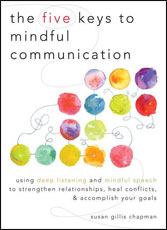Interruptions from Silence
"Before you speak, ask yourself: is it kind, is it necessary, is it true, does it Improve on the silence?"
— Sai Baba
"The Zen master Jakusho Kwong Roshi describes the way his teacher, Suzuki Roshi, communicated. 'Often he would talk with his eyes closed, as if he was going somewhere inside to verbalize.'
"It's a good way to collect yourself when you talk, kind of like a nice deep pause, that you go back to the source and then you verbalize again. This is an example of a communication practice my teacher Chogyam Trungpa Rinpoche described as punctuating our words with space. We practice this first style of positive interruption by intentionally bringing gaps into our conversations, opening the space for genuine listening. When we're speaking, we can go back to the source of our own words, listening to ourselves.
"There are three benefits that come from adding more silence to our conversations:
• "Silence protects our mindfulness practice, making it easier to pay attention to whatever we're doing in the present moment.
• "Silence enables us to deeply listen to our environment. This includes the words as well as the subtle messages from other people.
• "Silence tunes us in to our natural communication system, the intuitive way of knowing that flows beyond the level of words.
"When we're hiking along a beautiful forest trail with a friend, silence doesn't feel like an interruption. It feels natural to let our conversation fall apart from time to time so that we can share a deeper experience beyond words — the sounds, colors, and smells of the natural world around us. In our speedy modern society, we don't like silence. We're more like someone hiking in the woods while talking nonstop on a cell phone. We seem to have an unspoken agreement to avoid silence and stay distracted. When mindlessness rules, silence feels out of place, like the dead air on the radio or TV. We forget what we are missing.
"I remember a time in college when even a short gap of silence felt uncomfortable. But years later I spent nine years at Gampo Abbey, a Buddhist monastery, where much of our time was spent in silence. It wasn't a dead kind of silence. It was more like the listening space you feel on a quiet beach as you look out to sea, when you feel like the unseen energies of the place completely permeate your whole being.
"To cultivate silence within our conversations, the spiritual director of the abbey, Pema Chodron, teaches 'the pause practice' by asking someone to ring a bell periodically to interrupt whatever is going on at the moment. At the sound of the bell we drop what we're saying and pause for the length of three cycles of breathing. Then we resume as if nothing unusual had occurred. During the gap we have an opportunity to feel the contrast that openness brings, and sometimes this is a bit like feeling suspended in midair.
"The pause practice gives us a quick exit from the momentum of conversations so that we can remember the power of silence to reconnect us with the present moment. One way to adapt this practice is to use the ring of a cell phone or a red traffic light as a reminder to pause for a moment, take a deep breath, let your thoughts and words fall apart, and just listen."
